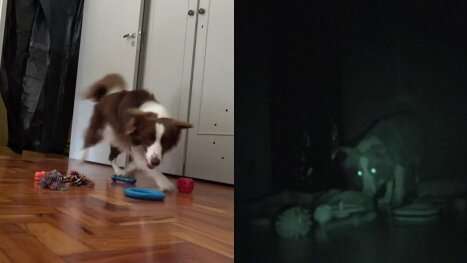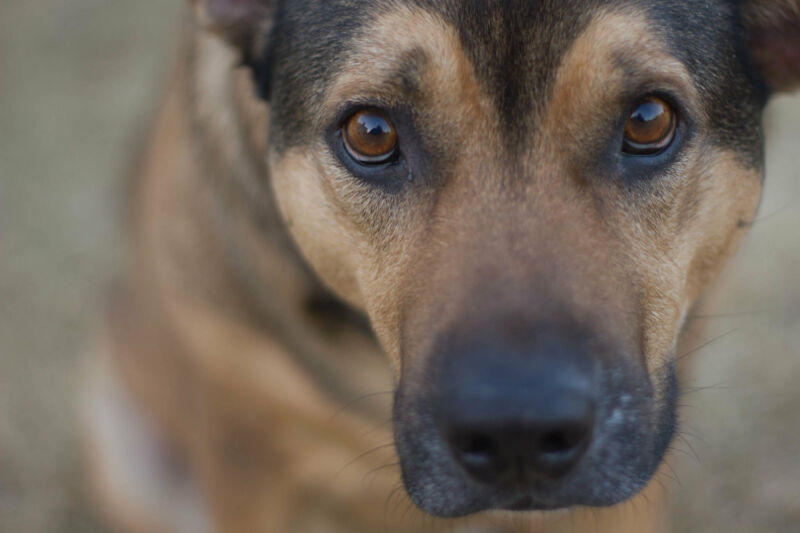A glimpse into the dog's mind: A new study reveals how dogs think of their toys

Many dog lovers want to know what goes on in their furry friends' minds. Now scientists are finally getting closer to the answer. In a new study just published in the journal Animal Cognition, researchers from the Family Dog Project (Eötvös Loránd University University, Budapest) found that dogs have a multi-modal mental image of their familiar objects. This means that when thinking about an object, dogs imagine the object's different sensory features, for instance, the way it looks or the way its smells.
The group of scientists assumed that the senses dogs use to identify objects, such as their toys, reflect the way the objects are represented in their minds. "If we can understand which senses dogs use while searching for a toy, this may reveal how they think about it," explains Shany Dror, one of the leading researchers of this study. "When dogs use olfaction or sight while searching for a toy, this indicates that they know how that toy smells or looks like."
In previous studies, the researchers discovered that only a few uniquely gifted dogs can learn the names of objects. "These gifted word learner dogs give us a glimpse into their minds, and we can discover what they think about when we ask them 'where is your teddy bear?'" explains Dr. Andrea Sommese, the second leading researcher.
In the first experiment, they trained three gifted word learner dogs and 10 typical family dogs (i.e., dogs that do not know the name of toys), to fetch a toy associated with a reward. During the training, dogs received treats and were praised for choosing this toy over a few distractor toys.
The researchers then observed how the dogs searched for the targeted toy, always placed among four others, both when the lights were on and off. All dogs successfully selected the trained toys, both in the light and in the dark. However, it took them longer to find the toys in the dark. Only the gifted word learner dogs participated in the second experiment. Here, the researchers aimed to find out what these dogs think about when they hear the name of their toys.
"Revealing the senses used by the dogs to search for the named toys gave us the possibility to infer what these dogs imagine when they hear, for example, 'teddy bear,'" explains Dr.. Claudia Fugazza, co-author of the study.
The gifted dogs were successful in selecting the toys named by their owners in the light and the dark. This reveals that, when they hear the name of a toy, they recall this object's different sensory features and they can use this "multisensory mental image" to identify it, also in the dark.
"Dogs have a good sense of smell, but we found that dogs preferred to rely on vision and used their noses only a few times, and almost only when the lights were off," clarifies Prof. Adam Miklósi, head of the Department of Ethology at ELTE University and co-author of the study. "Dogs sniffed more often and for longer in the dark. They spent 90% more time sniffing when the lights were off, but this was still only 20% of the searching time."
To conclude, the dogs' success in finding the toys and the different senses used while searching in the light and the dark reveals that, when dogs play with a toy, even just briefly, they pay attention to its different features and register the information using multiple senses.Exceptional learning capacities revealed in some gifted dogs
More information: Shany Dror et al, Multisensory mental representation of objects in typical and Gifted Word Learner dogs, Animal Cognition (2022). DOI: 10.1007/s10071-022-01639-z
Claudia Fugazza et al, Word learning dogs (Canis familiaris) provide an animal model for studying exceptional performance, Scientific Reports (2021). DOI: 10.1038/s41598-021-93581-2
Journal information: Animal Cognition , Scientific Reports
Provided by Eötvös Loránd University
A glimpse into the dog’s mind: A new study reveals how dogs think of their toys
Dogs have a “multi-modal mental image” of their familiar objects
Peer-Reviewed PublicationIMAGE: DOGS IMAGINE THE OBJECT’S DIFFERENT SENSORY FEATURES view more
CREDIT: CREDIT: COOPER PHOTO
Many dog lovers want to know what goes on in their furry friends’ minds. Now scientists are finally getting closer to the answer. In a new study just published in the journal of Animal Cognition, researchers from the Family Dog Project (Eötvös Loránd University University, Budapest) found out that dogs have a “multi-modal mental image” of their familiar objects. This means that, when thinking about an object, dogs imagine the object’s different sensory features. For instance, the way it looks or the way its smells.
The group of scientists assumed that the senses dogs use to identify objects, such as their toys, reflect the way the objects are represented in their minds. “If we can understand which senses dogs use while searching for a toy, this may reveal how they think about it” explains Shany Dror, one of the leading researchers of this study. “When dogs use olfaction or sight while searching for a toy, this indicates that they know how that toy smells or looks like”.
In previous studies, the researchers discovered that only a few uniquely gifted dogs can learn the names of objects. “These Gifted Word Learner dogs give us a glimpse into their minds, and we can discover what they think about when we ask them - Where is your Teddy Bear? –“ explains Dr. Andrea Sommese, the second leading researcher.
In the first experiment, they trained 3 Gifted Word Learner dogs and 10 typical family dogs (i.e., dogs that do not know the name of toys), to fetch a toy associated with a reward. During the training, dogs received treats and were praised for choosing this toy over a few distractor toys.
VIDEOABSTRACT: https://www.youtube.com/watch?v=UVC1IzdLJP8
The researchers then observed how the dogs searched for the targeted toy, always placed among 4 others, both when the lights were on and off. All dogs successfully selected the trained toys, both in the light and in the dark. However, it took them longer to find the toys in the dark. Only the Gifted Word Learner dogs participated in the second experiment. Here, the researchers aimed to find out what these dogs think about when they hear the name of their toys.
“Revealing the senses used by the dogs to search for the named toys gave us the possibility to infer what these dogs imagine when they hear, for example, Teddy Bear explains Dr. Claudia Fugazza, co-author of the study.
The Gifted dogs were successful in selecting the toys named by their owners in the light and the dark. This reveals that, when they hear the name of a toy, they recall this object’s different sensory features and they can use this “multisensory mental image” to identify it, also in the dark.
“Dogs have a good sense of smell, but we found that
dogs preferred to rely on vision and used their noses only a few times, and almost only when the lights were off”
clarifies Prof. Adam Miklósi, head of the Department of Ethology at ELTE University and co-author of the study. “Dogs sniffed more often and for longer in the dark. They spent 90% more time sniffing when the lights were off, but this was still only 20% of the searching time”.
To conclude, the dogs’ success in finding the toys and the different senses used while searching in the light and the dark reveals that, when dogs play with a toy, even just briefly, they pay attention to its different features and register the information using multiple senses.
This research is part of the Genius Dog Challenge research project that aims to understand the unique talent that Gifted Word Learner dogs have. The researchers encourage dog owners who believe their dogs know multiple toy names, to contact them on the Genius Dog Challenge website.
JOURNAL
Animal Cognition
ARTICLE TITLE
Multisensory mental representation of objects in typical and Gifted Word Learner dogs
ARTICLE PUBLICATION DATE
8-Jun-2022












